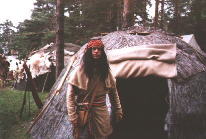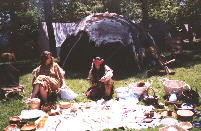


For most traditional peoples, time, as conceived by the majority, does not exist. The seasons flow in a great circle, repeated again and again. Customs outlive knowledge of their origins and are elevated to the sacred; reverence for them influences social behavior, and there is no need for laws to be written down and argued over. In pre-contract North America, youngsters were generally treated with indulgence by all members of the community: thus they were naturally disposed to take care of others in return. Trained from youth to place the tribe above individual concerns, all knew that the tribe would take care of them.
If there was any loser in the War of 1812 it was the Native People of North America. In the summer of 1815, the United States signed fifteen treaties with the tribes, guaranteeing their status as of 1811. But it did not return an acre of land. The dream of the Indian state never came true. Did the British ever believe it would? The war that bolstered national feeling on both sides of the border crippled the pride of the native peoples. As cilvilization marched westward, the Indians retreated. Tecumseh's tribe the Shawnne, found themselves drifting from reservation to reservation in Kansas and Oklahoma. The Winnebago of Green Bay, ravaged by war and disease, moved to Iowa, then Minnesota and finally Nebraska. The Miami ended on reservations in Kansas, the Potawatomi in Oklahoma.
Native culture changed. The "Old Ways" were gone. The shock of this change is only now being understood today. Natives went from the stone age to the industrial revolution in one lifetime.
It should also be noted that the Native people fought on both sides of this conflict with bravery. But you will not find many lists of their war dead or to their contribution in history books.
ClICK HERE to see the weapons used by the Native tribes during the war.
CLICK HERE to see the plaque in the village of Queenston.
CLICK HERE to see a plaque in the Holy Trinity Churchyard in the village of Chippawa.
Lower Canada (Quebec) ... 1,100 warriors
UpperCanada ... 700 - 800 warriors
Old North West: Ohio, Michigan, and Illinois Territory ... 9,000 warriors
New York & Pennsylvania ... 1,050 warriors
There were also Delawares, Algonkian, Shawnnes, Wyandots, Sandusky Senecas fighting on the side of the United States. No doubt there were many more Native Warriors fighting in the War of 1812, determining native military strength is difficult, because of poor and conflicting information.
